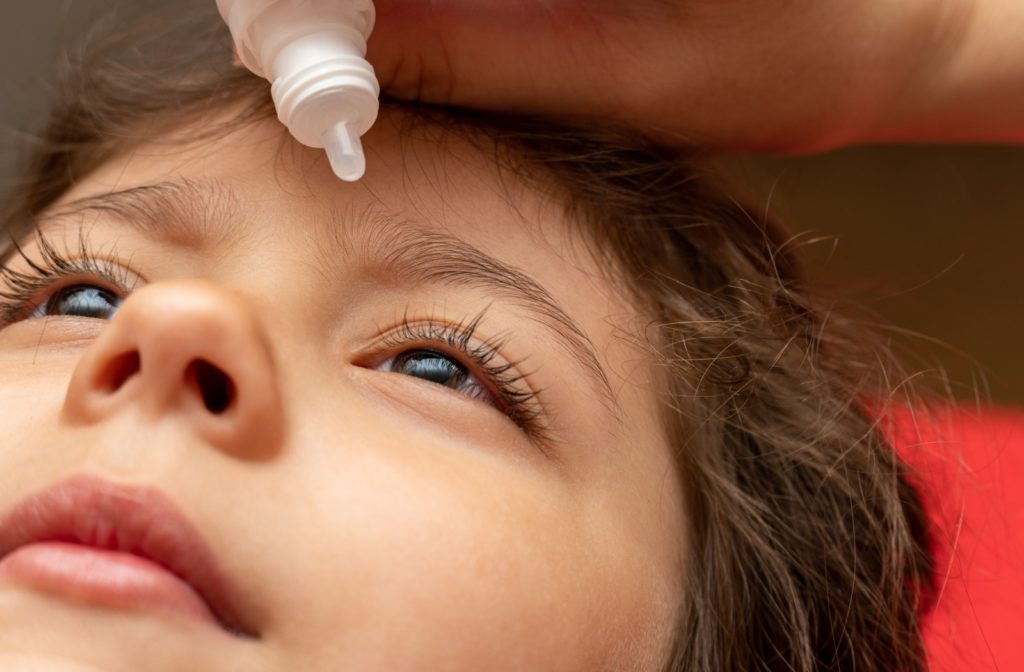Your child’s eyes are constantly going to be growing and developing. It’s completely natural—it’s a part of growing up. Sometimes, they might deal with some irritation or discomfort due to these changes. While eye drops can help them find relief, proper care is essential to keeping their eyes safe.
There are plenty of child-safe eye drops for all kinds of situations. You should visit your optometrist for a children’s eye exam—this way, an eye care professional can find eye drops that meet your child’s unique situation. Whether they need eye drops for myopia, dryness, allergies, or any other situation, your optometrist can help.
Types of Eye Drops for Kids
When dealing with eye discomfort in kids, knowing the cause is key. Eye drops aren’t universal, and the right drops for your child need to address the underlying reason they’re experiencing symptoms.
Atropine Eye Drops for Kids
Atropine drops are part of myopia control, a group of strategies aiming to slow how far nearsightedness progresses. These drops aren’t available over-the-counter—you’ll need a prescription from an optometrist.
These atropine drops work by dilating the pupil, which lets more light in. They also relax the eye’s focusing muscles, slowing the progression of nearsightedness. When used as recommended, they’re an excellent way to protect a child’s future vision.
Antihistamine Eye Drops for Kids
If your child’s eyes are itchy, watery, or irritated, it could be due to allergies. This is when antihistamine drops become ideal. They work by inhibiting histamines—the chemicals their body makes when exposed to an allergen.
These drops are a great way to find relief from common allergy symptoms. They’re available both over-the-counter and in prescription form. However, proper use is key to keeping your child’s eyes safe. Always talk to your optometrist if your child needs these drops often—they can help you rule out other eye conditions.
Antibacterial Eye Drops for Kids
Antibacterial drops are specifically designed to treat infections like conjunctivitis (also known as pink eye). These need a prescription—the antibiotics in these drops are too powerful to leave unchecked.
Antibacterial eye drops work by eliminating the bacteria causing the infection. They have a short shelf life once opened, so make sure your child uses them as prescribed. These shouldn’t be shared, and your child needs to keep taking the drops even after symptoms recede. Antibacterial drops are usually used for a week or so, though it depends on the infection.
Anti-Inflammatory Eye Drops for Kids
If your child’s eyes are inflamed, anti-inflammatory drops can help. These come in both prescription and over-the-counter forms. Anti-inflammatory drops help reduce swelling and discomfort but usually require careful supervision—misuse can lead to worse side effects.
These drops are ideal for:
- Redness and swelling
- Dry eyes
- Uveitis
- Overall irritation
Always consult your optometrist before using anti-inflammatory drops—especially for long-term problems. If your child regularly needs these eye drops, visit an optometrist to rule out underlying conditions.

Do Eye Drops Expire?
Eye drops don’t last forever. They all expire, and their lifespan depends on whether they have preservatives or not.
Eye drops with preservatives tend to last longer, usually around 30 days or so. Drops without them have a much shorter shelf life—sometimes as short as 24 hours after opening. Always make sure to check the instructions and toss out any bottle past its expiration date.
Using expired eye drops means they’re significantly less effective. They may not be able to properly do their job. But beyond that, old drops can introduce new bacteria to your child’s eyes—and this can make most conditions significantly worse.
Expired eye drops can cause:
- Eye infections
- Redness and irritation
- Allergic reactions
- Swelling
Don’t put your child’s eyes at risk. Eye drops should be treated like any other medicine—if there’s a chance they could harm your child, immediately discard them. Then, talk to your optometrist to discuss replacements.
Tips for Helping a Child Use Eye Drops
Getting kids to cooperate with eye drops isn’t always easy. It can be intimidating at first—but you can take some simple steps to make the process smoother.
Here are some simple tips to help your child feel more comfortable with eye drops:
- Explain why the drops are needed in terms they’ll understand. Use phrases like “This will help your eyes feel better.”
- Have your child lie down and look up while keeping their eyes open.
- Drop the liquid in the corner of the eye so it can naturally flow in when they blink.
- Use distractions, such as a favourite toy or video, to keep their focus elsewhere.
- Offer small rewards, like a sticker or a favourite snack, as positive reinforcement afterward.
It’s important to remember that patience is key. Making the experience relaxed can go a long way in getting it done without frustration. Then, your child can enjoy clear and comfortable vision once again!
Book Your Next Appointment Today
Your child’s comfort and vision are important to their daily life, but discomfort can be a significant problem. Whether they’re dealing with dryness, allergies, or nearsightedness, eye drops can help—and so can our team at Discover Eyecare. We’re here to help keep your child’s vision clear, so book an appointment with us today! Together, we can make your child’s eye health a priority, just like they deserve.



